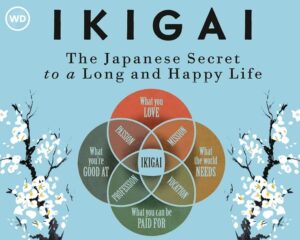
Pic Courtesy: webduniya
Ikigai is a Japanese concept that means your ‘reason for being’.
The term compounds two Japanese words: iki (生き, meaning ‘life; alive’) and kai (甲斐, meaning ‘(an) effect; (a) result; (a) fruit; (a) worth; (a) use; (a) benefit; a reason for living [being alive]; a meaning for [to] life; what [something that] makes life worth living; a raison d’être’.
The word has a number of translations, and all of them are correct:
- reason to live
- the purpose of life
- reason for being
- the meaning of life
- reason to get up in the morning or jump out of bed
- what makes life worth living
- the thing that you live for
- happiness of being
- a raison d’etre
The Oxford English Dictionary defines ikigai as “a motivating force; something or someone that gives a person a sense of purpose or a reason for living”. Generally, it may refer to something that brings pleasure or fulfillment.
A literal translation doesn’t quite give insight into the term and its importance.
Understanding IKAGAI
The concept of ikigai is said to have evolved from the basic health and wellness principles of traditional Japanese medicine. This medical tradition holds that physical well-being is affected by one’s mental/emotional health and sense of purpose in life.
Japanese psychologist Michiko Kumano (2017) has said that ikigai is a state of well-being that arises from devotion to activities one enjoys, which also brings a sense of fulfillment.
Ken Mogi, a neuroscientist and author of Awakening Your Ikigai, says that ikigai is an ancient and familiar concept for the Japanese, which can be translated simply as “a reason to get up in the morning” or, more poetically, “waking up to joy.”
Your ikigai doesn’t have to be one unique talent that drives you to share the best of yourself until the very end. This contradicts the Japanese perspective of ikigai. Japanese author, Ken Mogi describes ikigai as a spectrum, and that you can have several ikigai, anything from enjoying your morning coffee to working towards a life-defining goal.
Ikigai also appears related to the concept of flow, as described in the work of Hungarian–American psychologist Mihaly Csikszentmihalyi. Flow is a string of “best moments” or moments when we are at our best. These best moments “usually occur when a person’s body or mind is stretched to its limit, in a voluntary effort to accomplish something difficult and worthwhile”. Flow can be said to occur when you are consistently doing something you love and that you are good at, with the possible added benefit of bringing value to others’ lives. In such a case, the flow might be seen as in tune with your ikigai, or activities that give your life meaning and purpose.
It is important to note that ikigai does not typically refer only to one’s personal purpose and fulfillment in life, without regard to others or society at large. Ikigai brings meaning, purpose, and fulfillment to your life, while also contributing to the good of others.
Further, it is said that everyone has an ikigai – their particular intersection of passion, talent, and potential to benefit others. It is only a matter of finding it.
The 10 Rules of IKIGAI
The book IKIGAI: The Japanese Secret to a Long and Happy Life by Héctor García and Francesc Miralles, concludes with 10 rules of ikigai. These are suggestions or habits one could adopt to improve one’s health and well-being, so as to live your ikigai.
- Stay active; don’t retire. It is important to keep doing things of value, making progress, bringing beauty or utility to others, helping out, and shaping the world around you, even after your “official” professional activity has ended.
“Only staying active will make you want to live a hundred years”.
-Japanese Proverb
- Take it slow. Being in a hurry is inversely proportional to the quality of life. When we leave urgency behind, life and time take on new meaning. Hurry makes things go out of control and creates stress.
“Walk slowly and you’ll go far.”
-Old Saying
- Don’t fill your stomach. Less is more when it comes to eating for long life. According to the 80 percent rule, in order to stay healthier, we should eat a little less than our hunger demands.
“Hara Hachi Bu: Fill your belly to 80%”.
-Japanese Saying
- Surround yourself with good friends. Friends are the best medicine, there for confiding worries over a good chat, sharing stories that brighten your day, getting advice, having fun, dreaming . . . in other words, living.” Without relationships and friendships, we can’t experience connection, intimacy or love, nor can we share our joys, hopes, struggles, and fears.
“People who isolate themselves can’t have ikigai – meaning or purpose. Ikigai is only found in interpersonal relationships”.
– Ishikawa Tatsuzō
- Get in shape. A physically active body needs little maintenance and keeps running for a long time. Plus, exercise releases hormones that make us feel happy. Exercises like yoga, qigong, tai chi, and shiatsu are elixirs of youth, endorsed by science.
- Smile. A cheerful attitude is not only relaxing, but it also helps make friends.
- Reconnect with nature. Human beings are made to be part of the natural world. Japanese word shinrin-yoku, means ‘forest bathing’ and means connecting with nature using the five senses of sight, hearing, taste, smell, and touch. It is a mindfulness practice to help you reconnect with nature so that you can rejuvenate the body and give the mind a moment of peace.
- Give thanks. To your ancestors, to nature, which provides you with the air you breathe and the food you eat, to your friends and family, to everything that brightens your days and makes you feel lucky to be alive. Spend a moment every day giving thanks, and you’ll watch your stockpile of happiness grow.”
- Live in the moment. Stop regretting the past and fearing the future. Today is all you have. Make the most of it. Make it worth remembering.
“The present moment is all you ever have. There is never a time when your life is not ‘this moment.’ Is this not a fact?”
– Eckhart Tolle
- Follow your ikigai. There is a passion inside you, a unique talent that gives meaning to your days and drives you to share the best of yourself until the very end.
Bottom Line
If you don’t know what your ikigai is yet,
your mission should be to discover it.”
Question
Have you discovered your IKIGAI?
Suggestions and value additions are most welcome
Please share your IKIGAI in the comments column. It may help someone else discover theirs.
For regular updates, please register here
References and credits
To all the online sites and channels.
https://en.wikipedia.org/wiki/Ikigai
https://www.betterup.com/blog/what-is-ikigai
https://positivepsychology.com/ikigai/
https://www.betterup.com/blog/what-is-ikigai
https://ikigai-living.com/what-is-ikigai/
https://www.brit.co/ikigai-10-things-worlds-longest-living-people-do/
Disclaimer:
Information and data included in the blog are for educational & non-commercial purposes only and have been carefully adapted, excerpted, or edited from sources deemed reliable and accurate. All copyrighted material belongs to respective owners and is provided only for purposes of wider dissemination.



